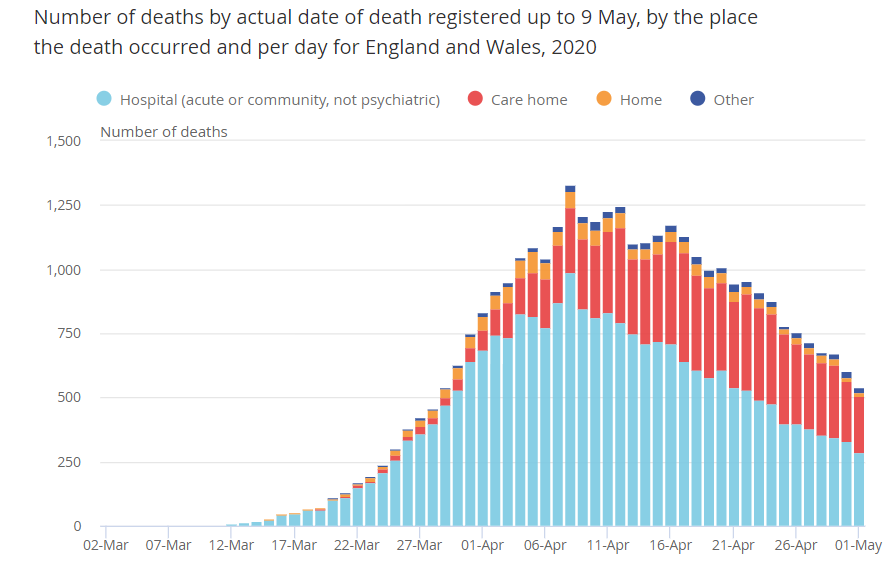The Health Secretary, Matt Hancock, made a number of comments about the how Covid-19 is affecting Britain’s care homes in media interviews today.
He spoke after new figures from the Office for National Statistics (ONS) shed light on how many people are dying in care homes.
What are the facts?
How many deaths in care homes?
Matt Hancock was asked about deaths in care homes in his BBC Radio 4’s Today programme this morning and said: “Some of our most vulnerable people live in care homes, yet only around a quarter of the deaths that have happened have been in care homes. That’s much lower than most international comparators.”
It’s true that since the beginning of the outbreak, about a quarter (26 per cent) of Covid-19 deaths registered in England and Wales have happened in care homes. The total number of care home deaths registered since the beginning of March is just over 9,000.
That’s according to ONS figures, based on registered deaths which mention Covid-19 on the death certificate, which can be viewed here (“Figure 8”).
But that proportion of deaths in care homes (the red bars on this ONS graph) has been rising week by week, as deaths in hospitals fall more quickly than in the care sector:
There’s a fairly clear trend in hospital deaths, with the peak occurring on April 8 and deaths falling steadily since then (the blue bars).
In care homes, separate data sets from the ONS and the Care Quality Commission also suggest that deaths are falling now, but the decline appears to be slower and more recent, with the peak arriving later in April.
This means that care home deaths are increasingly making up a bigger share of all deaths which mention Covid-19 on the death certificate.
In fact, the ONS says that in the most recent days, more than 40 per cent of all the coronavirus deaths it counts have been in care homes.
And care homes have not just had the coronavirus to deal with. The statistician Professor Sir David Spiegelhalter calculates that just under 11,500 non-Covid excess deaths (unexpected for the time of year) happened in care homes in the five weeks up to May 1.
That means people are dying in large numbers in care facilities and the deaths are not being attributed to the coronavirus. It has been suggested that this could partly be explained by doctors filling in death certificates incorrectly.
But Prof Spiegelhalter and other experts think it’s more likely that seriously ill people are staying away from hospitals and surgeries and dying in care homes instead.
What about those “international comparators”?
Making international comparisons of Covid-19 deaths is hard, as various government ministers and officials have often said themselves in recent weeks.
But there is some evidence that other countries in western Europe have seen higher proportions of Covid-19 deaths in their care sectors than the UK.
A research team hosted by the LSE found last month that more than half of all reported Covid-19 deaths in Belgium, France, Ireland, Norway and some Spanish regions were happening in care homes.
The study takes in countries with different age structures and different numbers of care home residents, and there is also a time lag, so it may be hard to make fair comparisons with the latest ONS data for England and Wales.
There are also issues with how deaths are recorded and reported in various countries: Germany doesn’t separate deaths in care homes from other “communal settings; Spain doesn’t publish a national total.
The researchers noted: “Due to differences in testing availabilities and policies, and to different approaches to recording deaths, international comparisons are difficult.”
Of course this comparison is all about the proportion of people dying in various settings. The actual numbers of deaths are wildly different in different countries. Some countries included in the study have only seen handfuls or hundreds of deaths in care homes, compared to more than 9,000 in England and Wales.
Care home workers
Matt Hancock was also asked about increased Covid-19 death rates among care home workers this morning.
He didn’t address the point directly but said the government had put in measures to protect people who work in care homes.
There is evidence this week that coronavirus death rates are higher in the care sector: this ONS study of Covid-19 death rates by occupation found significantly increased death rates among male and female social care workers, compared to the general population.
Female social care workers were almost twice as likely to die as women of the same age. For men working in the sector, the death rate was more than double the average for all men, adjusted for age.
The same study shows that doctors, nurses and other health workers did not have higher Covid death rates than average, when you allow for differences in age and sex.
So this is positive news for the NHS, and goes some way to allaying fears of frontline staff being exposed to greater risk. The study shows, for example, that the death rate in female nurses is no greater than among women of the same age in the general population.
But the same evidence suggests people working in care homes may be at greater risk.
The ONS study did not adjust for the possible effects of ethnicity, where people live or deprivation, so it doesn’t prove conclusively that occupation is the main risk factor.




